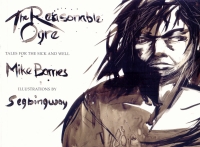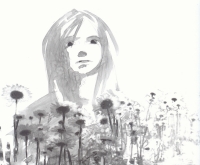| ________________
CM . . . . Volume XIX Number 9 . . . . November 2, 2012
excerpt:
The Reasonable Ogre: Tales for the Sick and Well is a collection of 12 modern fairy tales divided into four themes. In "Hard Bargains", Mike Barnes presents tales about compromise, sacrifice and mortality. Next, in "Small Plenties", he weaves stories about unlikely blessings in seemingly unfortunate circumstances. Thereafter, in "Luscious Dregs", Barnes explores the multiple meanings of 'dregs' by reviewing the lives of three young wastrels, a young woman who becomes lost in her own world and a pair of aging dancers as they enter the last vestiges of life. Finally, in "Strange Detours", he tells stories about one's personal agency in the face of injustice, fear and ruin. Each story is accompanied by black and white illustrations drawn with ink brush and wash by Toronto artist Segbingway.
However, equally pervasive throughout the text is a resolute call for courage in action amidst such darkness. In "Neverday: The Grateful Sprites", a father and son are rewarded with surprising blessings for rescuing sprites from physical torment, the father with the gift of a child for taking great care not to harm the sprite as he released him from a spell; and the son with endless days of joyous anticipation for rescuing another sprite from cruel seamen. In "Grimus the Miser", readers will find a hero in a young boy who sacrifices a part of himself to break the cycle of suffering of an enslaved creature. Finally, in "The King's Huntsman", a weary soldier resolves to face his fear after years of anxiety and running away. The enduring quality of fairy tales is that they are mutable, flexible in their passage through time. These stories live and grow, arch, squeeze and expand through our ability to fit them into the structures of our lives. Barnes' fairy tales are challenging narratives that compel readers to think carefully about modern life and their interaction with a world ridden with disease, pollution, uncertainty and fear. The Reasonable Ogre: Tales for the Sick and Well was intellectually engaging and filled with haunting pieces of art that beautifully complemented each story. However, it is with hesitation that I recommend this book as the content is intended for an adult audience: young adult readers may find it difficult to relate and engage effectively with the subject matter. This book would be best suited for mature, older teens who enjoy literary novels and manga-inspired art. Recommended with reservations. Jenice Batiforra is a Branch Head Librarian at the Winnipeg Public Library in Winnipeg, MB.
To comment
on this title or this review, send mail to cm@umanitoba.ca.
Copyright © the Manitoba Library Association. Reproduction for personal
use is permitted only if this copyright notice is maintained. Any
other reproduction is prohibited without permission.
NEXT REVIEW |
TABLE OF CONTENTS FOR THIS ISSUE
- November 2, 2012.
AUTHORS |
TITLES |
MEDIA REVIEWS |
PROFILES |
BACK ISSUES |
SEARCH |
CMARCHIVE |
HOME |

 These stories will prove challenging to the young adult reader. They do not yield their lessons easily, and even when they are finally extricated (if at all), they do not provide the comfort or satisfaction of a happily-ever-after ending. Throughout the book, the tone and subject matter, as well as the accompanying illustrations, make it clear that these tales are not set in some imaginary place, but rather in the difficult realities we face daily. Segbingway's black and white strokes depicting indeterminate figures and bleak semi-urban landscapes reflect the gray areas and dark undercurrent of the stories. In the title story, "The Reasonable Ogre", as well as "Silver" and "The Jailed Wizards", Barnes makes it clear that we live in uncompromising times where circumstances demand a sacrifice; we cannot escape without losing something (limbs, sight, memories, freedom), and the most we can negotiate for is what we need. "Sloth's Minions" leaves one with a sense of horror and disgust at the thought of young men throwing away their lives in the most shocking ways to compete for who can gain the most fame with the least effort.
These stories will prove challenging to the young adult reader. They do not yield their lessons easily, and even when they are finally extricated (if at all), they do not provide the comfort or satisfaction of a happily-ever-after ending. Throughout the book, the tone and subject matter, as well as the accompanying illustrations, make it clear that these tales are not set in some imaginary place, but rather in the difficult realities we face daily. Segbingway's black and white strokes depicting indeterminate figures and bleak semi-urban landscapes reflect the gray areas and dark undercurrent of the stories. In the title story, "The Reasonable Ogre", as well as "Silver" and "The Jailed Wizards", Barnes makes it clear that we live in uncompromising times where circumstances demand a sacrifice; we cannot escape without losing something (limbs, sight, memories, freedom), and the most we can negotiate for is what we need. "Sloth's Minions" leaves one with a sense of horror and disgust at the thought of young men throwing away their lives in the most shocking ways to compete for who can gain the most fame with the least effort.